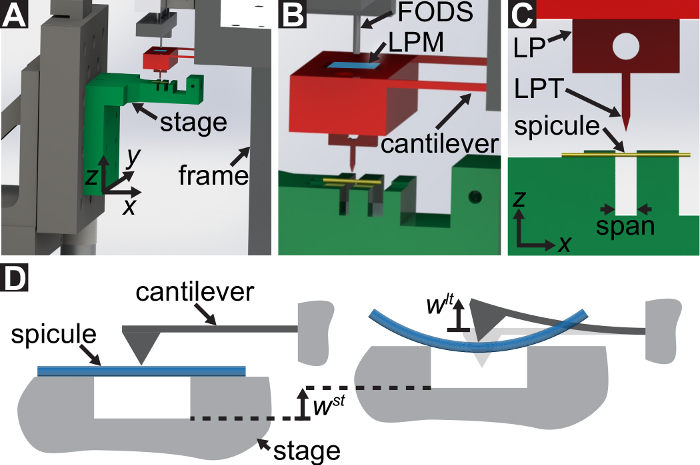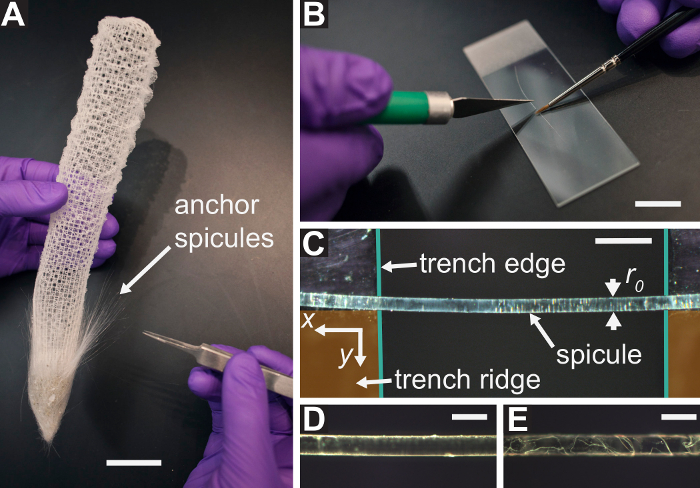测量海洋海绵针力学性能的毫米尺度弯曲试验系统
Summary
我们提出了一个协议, 执行三点弯曲试验的毫米规模纤维使用 custom-built 机械测试装置。该装置可以测量的力量范围从20µN 到 10 N, 因此可以容纳各种纤维大小。
Abstract
许多承重生物结构 (LBBSs)-例如羽毛轴和针-是小 (和 #60; 1 毫米), 但不是微观的。测量这些 LBBSs 的弯曲行为对于了解其显著的机械功能的起源是非常重要的。
我们描述一个执行三点弯曲试验的协议, 使用 custom-built 的机械测试装置, 它可以测量从 10-5到 101 N 的力, 以及从 10-7到 10-2 m 不等的位移.该机械试验装置的主要优点是可以方便地调整不同 LBBSs 的力和位移能力。该装置的工作原理类似于原子力显微镜。即, 力是应用到 LBBS 的负载点, 附加到一个悬臂的一端。用光纤位移传感器测量负载点位移, 并利用实测悬臂刚度将其转换为力。该装置的受力范围可通过使用不同刚度的悬臂来调节。
通过对海洋海绵Euplectella 蚯蚓的骨架元素执行三点弯曲试验, 演示了该设备的功能。骨骼元素–称为针–是直径约50µm 的二氧化硅纤维。我们描述了校准机械测试装置的程序, 在一个≈1.3 mm 跨度的三点弯曲夹具上安装针, 并执行弯曲试验。测量了施加于骨针的力及其在施加力位置的挠度。
Introduction
通过研究承重生物结构 (LBBSs) (如壳体和骨骼) 的结构, 工程师们开发出了强而韧的新型复合材料 ( 1)。结果表明, LBBSs 的优异力学性能及其与生物激发的对应关系与它们错综复杂的内部结构2有关。然而, LBBS 体系结构和机械性能之间的关系还没有得到充分的了解。测量 LBBS 的机械响应是了解其结构如何增强其机械性能的第一步。
然而, 重要的是, 用于测量 LBBS 的机械响应的测试类型与它的机械性能是一致的。例如, 由于羽毛必须支持空气动力载荷, 羽毛轴的主要功能是提供弯曲刚度3。因此, 弯曲试验是首选的单轴拉伸试验, 以测量其机械响应。事实上, 许多 LBBSs-如羽毛轴3、草茎4、针5、6、7、8–主要是由弯曲引起的变形。这是因为这些 LBBSs 是细长的-即, 它们的长度比它们的宽度或深度大得多。但是, 对这些 LBBSs 执行弯曲测试是有挑战性的, 因为它们在失败之前能够承受的力和位移范围从 10 -2到 102 N 和 10-4到 10-3 m, 分别是3,4,5,7,8. 因此, 用于执行这些机械测试的设备应分别具有≈10-5 N 和≈10-7 m (即传感器最大可力和位移的 0.1%) 的力和位移分辨率。
在商业上, 大规模的机械测试系统通常无法用这个分辨率来测量力和位移。当原子力 microscope-based 9、10或机械系统11测试设备有足够的分辨率时, 它们可以测量的最大力 (各自的位移) 小于LBBS 能承受的最大力 (各自位移)。因此, 要对这些 LBBSs 进行弯曲测试, 工程师和科学家必须依靠 custom-built 机械测试设备5,7,12,13。这些 custom-built 设备的主要优点是它们可以容纳大范围的力和位移。然而, 这些设备的构造和操作在文献中没有很好的记录。
一个协议被描述为执行三点弯曲试验使用 custom-built 机械测试设备, 可以测量力量范围从 10-5到 101 N 和位移范围从 10-7到 10-2 m。辅助材料中提供了机械试验装置各部件的技术图纸, 包括所有尺寸。该机械试验装置的主要优点是可以很容易地调整力和位移范围, 以适应不同的 LBBSs。该装置的工作原理类似于原子力显微镜9。在这个装置中, 一个试样被放置在一个不锈钢板的沟槽中 (参见图 1a-c)。沟槽的跨度是从光学显微测量为1278±3µm (平均±标准偏差; n = 10)。沟槽边缘在弯曲测试期间支持试样 (请参见图 1C和D)。此采样阶段附加到一个三轴平移阶段, 并位于铝楔下, 以便楔形位于沟槽跨度的中间 (请参见图 1C)。通过在方向中移动舞台 (参见 图 1A和C), 将试样推入楔形, 导致试样弯曲。
图 1A和C), 将试样推入楔形, 导致试样弯曲。
我们将楔形作为负载点 (LPT) 和包含楔形的设备的组件作为负载点 (LP)。该 LP 连接到悬臂的一端, 其位移由光纤位移传感器 (FODS) 测量。FODS 发出红外光, 它反射到位于 LP 顶部表面的镜像 (请参见图 1B), 并由 FODS 中的光纤接收。用≈5 mm 方形片抛光硅片作为 lp 镜, 用环氧树脂贴在 lp 上。FODS 通过比较发射和反射光的强度来测量位移。悬臂刚度和位移是用来计算的力量,, 经验的楔由于其与标本的相互作用.  悬臂位移也用于计算试样在楔形下方的截面位移,.
悬臂位移也用于计算试样在楔形下方的截面位移,.  Cantilever-based 力传感器已用于一些微型和宏观的机械测试研究10,11,12,13,14。这里介绍的具体设计是由一个用于执行粘接接触实验的机械测试装置14改编的。类似的设计也被用于商业上可用的微摩擦15,16。
Cantilever-based 力传感器已用于一些微型和宏观的机械测试研究10,11,12,13,14。这里介绍的具体设计是由一个用于执行粘接接触实验的机械测试装置14改编的。类似的设计也被用于商业上可用的微摩擦15,16。

图 1: custom-built 机械测试设备概述.(a) 计算机辅助设计渲染设备。舞台组件以绿色高亮显示。力传感子组件 (悬臂式、负载点 (LP)) 以红色突出显示。(B) 放大的视图 (A)。lp 镜像以蓝色显示在 FODS 下 lp 的顶部表面上, 并被标记为 “泥倾泻”。(C) 用于描述平移阶段的运动的坐标系。通过调配 the 阶段在协议的步骤1.9 中, 使方向与 LP 镜像表面的向量法线一致.  (D) 三点弯曲配置示意图, 显示骨针和测量的位移和的变形.
(D) 三点弯曲配置示意图, 显示骨针和测量的位移和的变形. 
 请单击此处查看此图的较大版本.
请单击此处查看此图的较大版本.
通过对海洋海绵Euplectella 蚯蚓6、7中的骨骼元素执行三点弯曲测试,演示了该设备的功能.这海绵的骨架是一个组装的花丝, 称为针 (请参见图 2A)。针是≈50µm 厚, 主要由二氧化硅6组成。Biosilica-based 针是在属于 Demospongiae、Homoscleromorpha 和 Hexactinellida 类的海绵中发现的。海绵, 如E. 蚯蚓, 属于类 Hexactinellida 也被称为 “玻璃海绵”。虽然玻璃海绵的针主要由二氧化硅组成, 它已经表明, 二氧化硅往往包含一个有机基质组成的胶原蛋白17,18或甲壳素19,20,21. 此有机基质在二氧化硅矿中起重要作用18,20。此外, 在一些针, 有机基质也可作为一个模板的矿钙的22。除了在二氧化硅中分布外, 有机基质还可以形成不同的层, 将骨针的二氧化硅分成同心、圆柱形的颗粒6,23。结果表明, 这种同心、层状结构会影响针的变形行为6,7,8,24,25,,26.因此, 针的力学性质是由他们的化学组合 (i. e., 硅蛋白复合物的化学结构) 和他们的建筑学27。玻璃海绵针的化学结构和结构仍在调查中24,28,29。
E. 蚯蚓中的大多数针都被粘合在一起, 形成一个僵硬的骨骼笼。然而, 在骨架的底部有一簇非常长的 (≈10厘米) 针称为锚针 (请参见图 2a)。我们描述了在锚针的小段上执行三点弯曲试验的协议。
在协议的步骤 1中, 描述了 custom-built 机械测试装置组件的装配和对准过程。协议的步骤 2和4提供了用于生成用于在弯曲测试中计算力和位移的校准数据的说明。在步骤 3中介绍了准备骨针节并将其装入测试夹具所采取的步骤。在骨针节上进行弯曲测试的过程在步骤 5中介绍。最后, 在代表性结果  部分中, 在步骤 2和
部分中, 在步骤 2和 4中获得的校准数据与在步骤 5中获得的弯曲测试数据一起使用和。
4中获得的校准数据与在步骤 5中获得的弯曲测试数据一起使用和。

图 2: 剖切和检查E. 蚯蚓针的过程.(A) E. 蚯蚓的骨架。一簇独立的锚针显示在骨架的底部。刻度条是〜 25 mm (B) 一个单一的锚骨针是固定在显微镜幻灯片上使用 #00000 红色紫貂刷和切片使用刀片。刻度线为 ~ 12 mm (C), 在样品台上的沟槽上放置了一个蚯蚓骨针的部分。沟槽边缘和沟槽脊分别以蓝绿色和橙色突出显示。骨针被推向沟槽脊, 以确保其轴线垂直于沟槽边缘。(D) 一个骨针的显微图像, 它通过了协议的步骤 3.4中描述的检查过程, 它描述了如何确定骨针节是否已损坏并应丢弃。(E) 一个骨针的显微图像, 其中包含许多裂缝, 并且缺少大量的二氧化硅层, 这将使该协议的步骤 3.4中描述的检查过程失败。缩放条形图 = 250 µm (C)、100µm (D) 和100µm (E)。请单击此处查看此图的较大版本.
Protocol
Representative Results
Discussion
该协议的几个步骤对于确保精确测量力和位移尤为重要。虽然这些关键步骤中的一些是通用的所有三点弯曲试验, 其他是唯一的这种机械测试装置。
在协议的步骤 1.2中, 将对 LP 镜像进行清理并检查是否有划痕, 并在协议的步骤 1.6中设置 FODS 增益。对于步骤 2、 4和协议的5 , 增益和 LP 镜像的反射率是常量非常重要?…
Divulgazioni
The authors have nothing to disclose.
Acknowledgements
这项工作得到了国家科学基金会的支持 [材料和结构的力学方案, 赠款编号 1562656];和美国机械工程师学会 [Haythornthwaite 青年研究员奖]。
Materials
| TMC 36" x 48" isolation table with 4" CleanTop breadboard | TMC | 63-563 | Isolation Table |
| Diffeential Screw Adjuster | Thorlabs | DAS110 | For stage leveling plate |
| 1" Travel Micrometer Head with 0.001" Graduations | Thorlabs | 150-801ME | For stage leveling plate |
| Right-Angle Bracket for PT Series Translation Stages, 1/4"-20 Mounting Holes | Thorlabs | PT102 | For microscope mount |
| 1" Dovetail Translation Stage, 1/4"-20 Taps | Thorlabs | DT25 | For microscope mount |
| 1" Translation Stage with 1/4"-170 Adjustment Screw, 1/4"-20 Taps | Thorlabs | PT1B | For microscope mount |
| 12" Length, Dovetail Optical Rail | Edmund Optics | 54-401 | For microscope mount |
| 2.5" Width, Dovetail Carrier | Edmund Optics | 54-404 | For microscope mount |
| 0.5" Width, Dovetail Carrier | Edmund Optics | 54-403 | For microscope mount |
| InfiniTube Mounting C-Clamp with ¼-20 | Edmund Optics | 57-788 | Microscope component |
| Standard (with no In-Line Attachment), InfiniTube | Edmund Optics | 56-125 | Microscope component |
| Standard In-Line Attachment (Optimized at 2X-10X), InfiniTube | Edmund Optics | 56-126 | Microscope component |
| Mitutoyo/Achrovid Objective Adapter (M26 to M27) | Edmund Optics | 53-787 | Microscope component |
| 5X Infinity Achrovid Microscope Objective | Edmund Optics | 55-790 | Microscope component |
| 0.316" ID, Fiber Optic Adapter SX-6 | Edmund Optics | 38-944 | Microscope component |
| ¼" x 36", Flexible Fiber Optic Light Guide | Edmund Optics | 42-347 | Microscope component |
| 115V, MI-150 Fiber Optic Illuminator w/IR Filter and Holder | Edmund Optics | 55-718 | Microscope component |
| Allied Vision Manta G-223 2/3" Color CMOS Camera | Edmund Optics | 88-452 | Microscope component |
| Power Supply for Manta/ Guppy Pro/ Stingray/ Pike | Edmund Optics | 68-586 | Microscope component |
| 1/4" Travel Single Axis Translation Stage | Thorlabs | MS1S | FODS micrometer |
| Analog Reflectance Dependent Fiber Optic Displacement Sensor | Philtec | D20 | FODS |
| 30V, 3A DC Power Supply | Agilent | U8001A | Power supply for DAQ and FODS |
| 14-Bit, 48 kS/s Low-Cost Multifunction DAQ | National Instruments | USB-6009 | DAQ for FODS |
| Three Axis Motorized Translation Stage | Thorlabs | Thorlabs T25 XYZ-E/M | Translation stage |
| T-Cube DC Servo Motor Controller | Thorlabs | TDC001 | Motor controller for stage |
| T-Cube Power Supply | Thorlabs | TPS001 | Power supply for motor controller |
| National Instruments LabVIEW (2013 SP1) | National Instruments | Used for running software | |
| National Instruments LabVIEW Vision Acquisition Software (2016) | National Instruments | Used for running software | |
| Nikon Eclipse Ci-POL Main Body | MVI | MDA96000 | Polarized light microscope |
| Nikon Pi Intermediate Tube with Analyzer Slider | MVI | MDB45305 | Polarized light microscope |
| Nikon Dia-Polarizer | MVI | MDN11920 | Polarized light microscope |
| Power Cord – 7'6" | MVI | 79035 | Polarized light microscope |
| Nikon P-Amh Mechanical Stage | MVI | MDC45000 | Polarized light microscope |
| Nikon Lwd Achromat Condenser | MVI | MBL16100 | Polarized light microscope |
| Nikon LV-NBD5BD-CH Manual Quint Nosepiece ESD | MVI | MBP60125 | Polarized light microscope |
| Nikon C-TF Trinocular Tube F | MVI | MBB93100 | Polarized light microscope |
| Nikon CFI 10X Eyepiece FN 22mm NC | MVI | MAK10110 | Polarized light microscope |
| Nikon TU Plan Flour BD 10x Objective | MVI | MUE42100 | Polarized light microscope |
| Venus Flower Basket Sponge | Denis Brand | N/A | Sponge skeleton |
| 3.5X Headband Flip-Up Magnifier | McMaster Carr | 1490T5 | Used for spicule sectioning |
| Ø1" Silicon Wafer, Type P / <100> | Ted Pella | 16011 | Used for load point mirror |
| Low Lint Tapered Tip Cotton Swab | McMaster Carr | 71035T31 | Used for cleaning LP mirror |
| Rubber grip precision knife | McMaster Carr | 35575A68 | Used for sectioning spicules |
| Microscope Slides, frosted end, 75 x 25 x 1mm | Ted Pella | 260409 | Used for sectioning spicules |
| Sable Brushes, #00000, 0.08mm W x 4.0mm L | Ted Pella | 11806 | Used for handling spicules |
| PELCO Pro High Precision Tweezers, extra fine tips, superior finish | Ted Pella | 5367-5NM | Used for handling spicules |
| Dual Axis Linear Scale Micrometer | Edmund Optics | 58-608 | Used for calibrating the microscopes |
| FLEX-A-TOP FT-38 CAS | ESD Plastic Containers | FT-38-CAS | Used for storing spicules |
| Plastic Vial Bullseye Level | McMaster Carr | 2147A11 | Used for leveling the stage |
| Analytical Balance | Mettler Toledo | MS105DU | Used to mass calibration weights |
Riferimenti
- Wegst, U. G., Bai, H., Saiz, E., Tomsia, A. P., Ritchie, R. O. Bioinspired structural materials. Nat. Mater. 14 (1), 23-36 (2015).
- Meyers, M. A., McKittrick, J., Chen, P. Y. Structural biological materials: critical mechanics-materials connections. Science. 339 (6121), 773-779 (2013).
- Bodde, S. G., Meyers, M. A., McKittrick, J. Correlation of the mechanical and structural properties of cortical rachis keratin of rectrices of the Toco Toucan (Ramphastos toco). J. Mech. Behav. Biomed. Mater. 4 (5), 723-732 (2011).
- Gibson, L. J. The hierarchical structure and mechanics of plant materials. J. R. Soc. Interface. , (2012).
- Monn, M. A., Kesari, H. A new structure-property connection in the skeletal elements of the marine sponge Tethya aurantia that guards against buckling instability. Sci. Rep. 7, (2017).
- Monn, M. A., Weaver, J. C., Zhang, T., Aizenberg, J., Kesari, H. New functional insights into the internal architecture of the laminated anchor spicules of Euplectella aspergillum. Proc. Natl. Acad. Sci. U.S.A. 112 (16), 4976-4981 (2015).
- Monn, M. A., Kesari, H. Enhanced bending failure strain in biological glass fibers due to internal lamellar architecture. J. Mech. Behav. Biomed. Mater. , (2017).
- Levi, C., Barton, J. L., Guillemet, C., Bras, E., Lehuede, P. A remarkably strong natural glassy rod: the anchoring spicule of the Monorhaphis sponge. J. Mater. Sci. Letters. 8 (3), 337-339 (1989).
- Kesari, H., Doll, J. C., Pruitt, B. L., Cai, W., Lew, A. J. Role of surface roughness in hysteresis during adhesive elastic contact. Philos. Mag. Lett. 90 (12), 891-902 (2010).
- Croisier, F., et al. Mechanical testing of electrospun PCL fibers. Acta Biomater. 8 (1), 218-224 (2012).
- Haque, M. A., Saif, M. T. A review of MEMS-based microscale and nanoscale tensile and bending testing. Exp. Mech. 43 (3), 248-255 (2003).
- Gudlavalleti, S. . Mechanical testing of solid materials at the micro-scale. , (2002).
- Tohmyoh, H., Ishihara, M., Akanda, M. S., Yamaki, S., Watanabe, T., Iwabuchi, T. Accurate determination of the structural elasticity of human hair by a small-scale bending test. J. Biomech. 44 (16), 2833-2837 (2011).
- Waters, J. F. . Contact mechanics of biologically-inspired interface geometries. , (2009).
- Dai, Z., Gorb, S. N., Schwarz, U. Roughness-dependent friction force of the tarsal claw system in the beetle Pachnoda marginata (Coleoptera, Scarabaeidae). J. Exp. Biol. 205 (16), 2479-2488 (2002).
- Tramacere, F., Kovalev, A., Kleinteich, T., Gorb, S. N., Mazzolai, B. Structure and mechanical properties of Octopus vulgaris suckers. J. R. Soc. Interface. 11 (91), (2014).
- Ehrlich, H., et al. Nanostructural organization of naturally occurring composites: Part I. Silica-Collagen-based biocomposites. J. Nanomater. 53, (2008).
- Ehrlich, H., et al. Mineralization of the meter-long biosilica structures of glass sponges is templated on hydroxylated collagen. Nat. Chem. 2, 1084-1088 (2010).
- Ehrlich, H., et al. First evidence of the presence of chitin in skeletons of marine sponges. Part II. Glass sponges (Hexactinellida: Porifera). J. Exp. Zoo. 308 (4), 473-483 (2007).
- Ehrlich, H. Chitin and collagen as universal and alternative templates in biomineralization. Int. Geol Rev. 52, 661-699 (2010).
- Ehrlich, H., et al. Supercontinuum generation in naturally occurring glass sponge spicules. Adv. Opt. Mater. 4 (10), 1608-1613 (2016).
- Ehrlich, H., et al. Calcite reinforced silica-silica joints in the biocomposite skeleton of deep-sea glass sponges. Adv. Funct. Mater. 21, 3473-3481 (2011).
- Werner, P., Blumtritt, H., Zlotnikov, I., Graff, A., Dauphin, Y., Fratzl, P. Electron microscope analyses of the bio-silica basal spicule from the Monorhaphis chuni sponge. J. Struct. Biol. 191 (2), 165-174 (2015).
- Kolednik, O., Predan, J., Fischer, F. D., Fratzl, P. Bioinspired Design Criteria for Damage-Resistant Materials with Periodically Varying Microstructure. Adv. Funct. Mater. 21 (19), 3634-3641 (2011).
- Weaver, J. C., et al. Unifying design strategies in demosponge and hexactinellid skeletal systems. J. Adhes. 86 (1), 72-95 (2010).
- Walter, S. L., Flinn, B. D., Mayer, G. Mechanisms of toughening of a natural rigid composite. Mater. Sci. Eng. C. 27 (3), 570-574 (2007).
- Ehrlich, H. Silica biomineralization in Sponges. Encyclopedia of Geobiology. , 796-808 (2011).
- Zlotnikov, I., Werner, P., Fratzl, P., Zolotoyabko, E. Eshelby Twist as a possible source of lattice rotation in a perfectly ordered protein/silica structure grown by a simple organism. Small. 11 (42), 5636-5641 (2015).
- Zlotnikov, I., et al. A perfectly periodic three-dimensional protein/silica mesoporous structure produced by an organism. Adv. Mater. 26 (11), 1682-1687 (2014).
- Gere, J. M., Timoshenko, S. P. Chapter 5: Stresses in Beams. Mechanics of materials. , 205-217 (1997).
- Baratta, F. I., Matthews, W. T., Quinn, G. D. . Errors associated with flexure testing of brittle materials. , (1987).
- Quinn, G. D., Sparenberg, B. T., Koshy, P., Ives, L. K., Jahanmir, S., Arola, D. D. Flexural strength of ceramic and glass rods. J. Test. Eval. 37 (3), 1-23 (2009).
- Tattersall, H. G., Tappin, G. The work of fracture and its measurement in metals, ceramics and other materials. J. Mater. Sci. 1 (3), 296-301 (1966).

